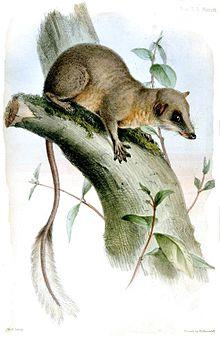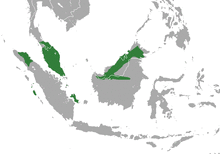| Pen-tailed treeshrew | |
|---|---|
 | |
| Illustration in 1848 species description | |
| Scientific classification | |
| Kingdom: | Animalia |
| Phylum: | Chordata |
| Class: | Mammalia |
| Order: | Scandentia |
| Family: | Ptilocercidae Lyon, 1913 |
| Genus: | Ptilocercus Gray, 1848 |
| Species: | P. lowii[1] |
| Binomial name | |
| Ptilocercus lowii[1] Gray, 1848 | |
 | |
| Pen-tailed treeshrew range | |
The pen-tailed treeshrew (Ptilocercus lowii) is a treeshrew of the family Ptilocercidae native to southern Thailand, the Malay Peninsula, Borneo, and some Indonesian islands.[2]
It is the only species in the genus Ptilocercus. All other treeshrew species are grouped in the family Tupaiidae.[1]
Alcohol resistance
The pen-tailed treeshrew is the only known mammal that consumes alcohol every night. Pen-tailed treeshrews studied in Malaysia spend several hours per night consuming the equivalent of 10 to 12 glasses of wine with an alcohol content up to 3.8% drinking naturally fermented nectar of the bertam palm. This nectar contains one of the highest alcohol concentrations of all natural foods. Pen-tailed treeshrews frequently consume large amounts of this nectar while showing no signs of intoxication. Measurements of a biomarker of ethanol breakdown suggest that they may be metabolizing it by a pathway that is not used as heavily by humans. Their ability to ingest high amounts of alcohol is hypothesized to have been an evolutionary adaptation in the phylogenic tree. However, how pen-tailed treeshrews benefit from this alcohol ingestion or what consequences of consistent high blood alcohol content might factor into their physiology is unclear.[3]
Taxonomy and evolutionary history
The Ptilocercidae are a family within the order Scandentia. Numerous morphological and genetic differences support the classification of the Ptilocercidae as a separate family from the rest of the treeshrews which diverged around 60 million years ago.[4][5] Treeshrews were considered a close relative of primates, but recent genetic data have concluded that the Dermoptera, not the treeshrews, are the appropriate out-group for study of primates.[4]
References
- ^ a b Helgen, K.M. (2005). "Ptilocercus lowii". In Wilson, D.E.; Reeder, D.M (eds.). Mammal Species of the World: A Taxonomic and Geographic Reference (3rd ed.). Johns Hopkins University Press. pp. 108–109. ISBN 978-0-8018-8221-0. OCLC 62265494.
- ^ a b Cassola, F. (2016). "Ptilocercus lowii". IUCN Red List of Threatened Species. 2016: e.T41491A22278277.
- ^ Wiens, F.; Zitzmann, A.; Lachance, M.-A.; Yegles, M.; Pragst, F.; Wurst, F. M.; von Holst, D.; Guan, S. L. & Spanagel, R. (2008). "Chronic intake of fermented floral nectar by wild tree-shrews". Proceedings of the National Academy of Sciences. 105 (30): 10426–10431. Bibcode:2008PNAS..10510426W. doi:10.1073/pnas.0801628105. PMC 2492458. PMID 18663222.
- ^ a b Janečka, J. E., Miller, Thomas, W., Pringle, H., Wiens, F., Zitzmann, A., Helgen, K. M., Springer, M. S. and Murphy, W. J. (2007). "Molecular and Genomic Data Identify the Closest Living Relative of Primates". Science. 318 (5851): 792–794. Bibcode:2007Sci...318..792J. doi:10.1126/science.1147555. PMID 17975064. S2CID 12251814.
- ^ Roberts, T.E.; Lanier, H.C.; Sargis, E.J.; Olson, L.E. (2011). "Molecular phylogeny of treeshrews (Mammalia: Scandentia) and the timescale of diversification in Southeast Asia". Molecular Phylogenetics and Evolution. 60 (3): 358–372. doi:10.1016/j.ympev.2011.04.021. PMID 21565274.
External links
